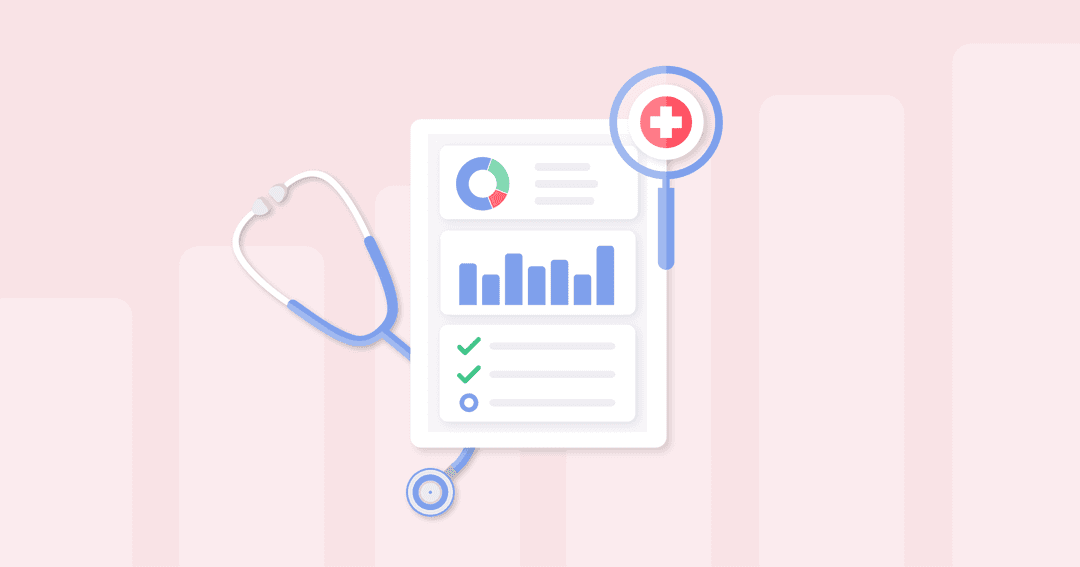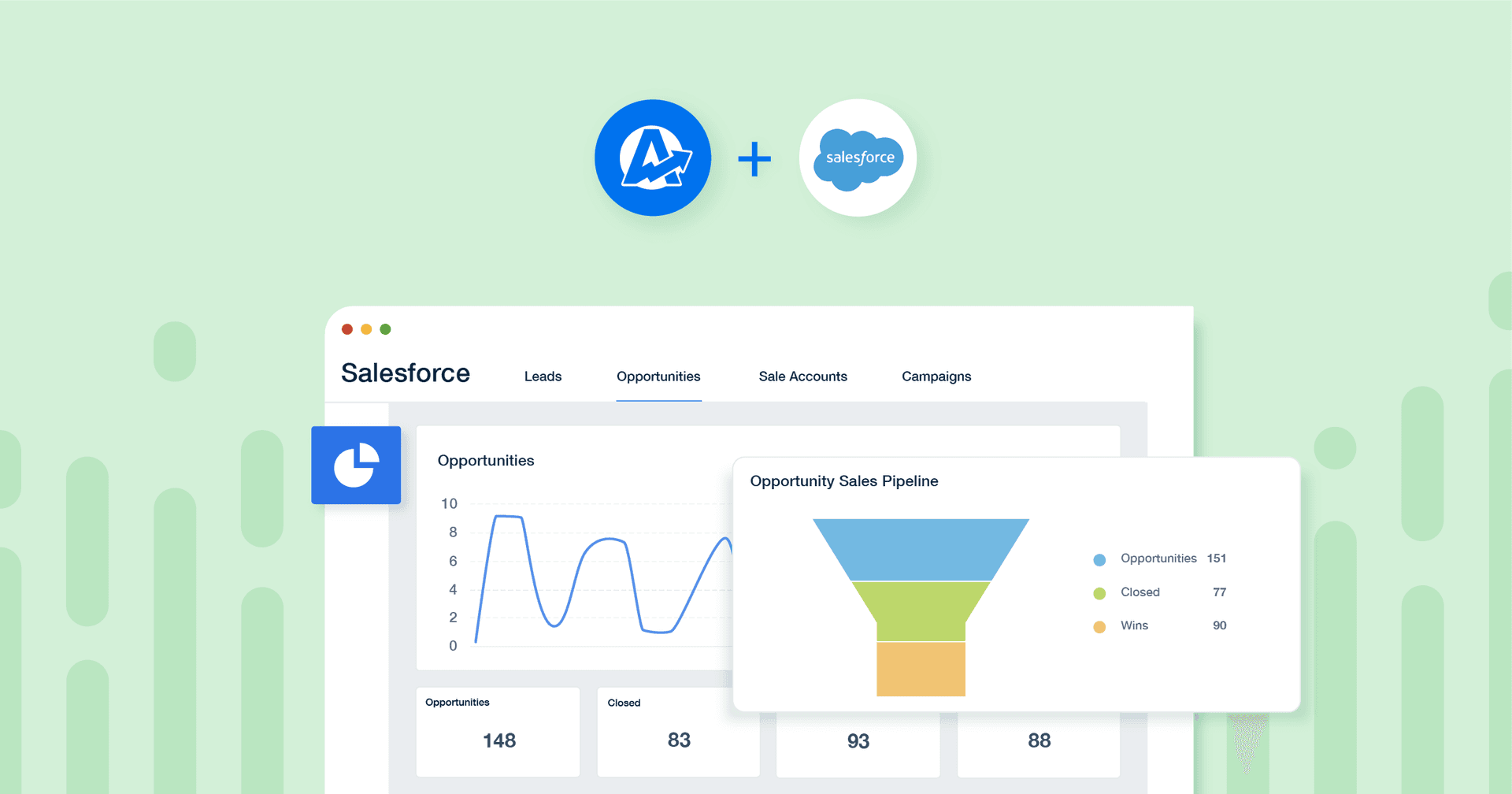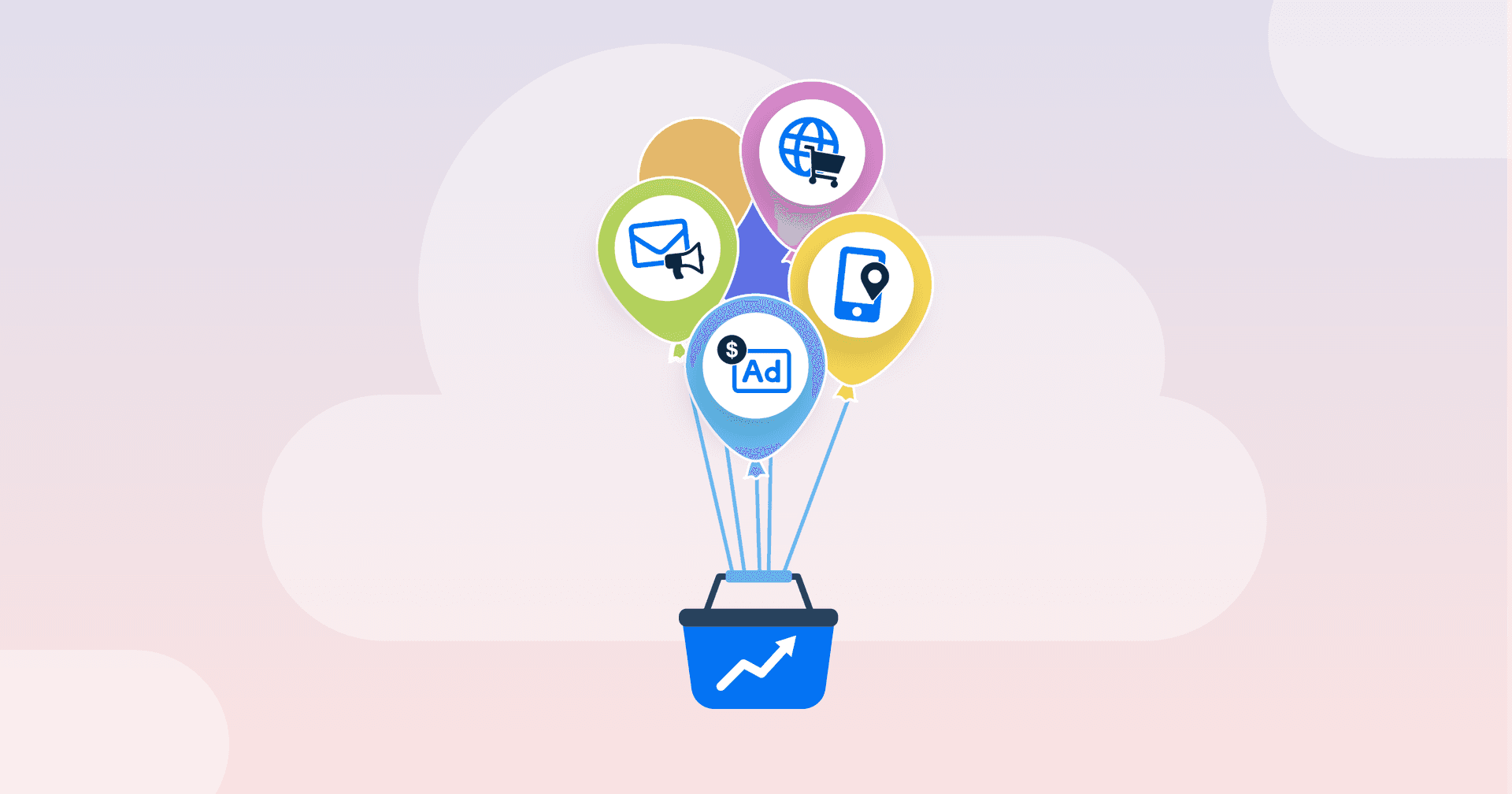Table of Contents
Table of Contents
- Why use a healthcare marketing dashboard?
- Benefits of using a dashboard to track healthcare marketing success
- Tracking progress according to your clients’ main goals
- Healthcare marketing KPIs and how to track them
- Healthcare marketing dashboard example
- Creating your healthcare marketing dashboard with AgencyAnalytics
- Flip your healthcare marketing dashboards into client-ready reports
7,000+ agencies have ditched manual reports. You can too.
Free 14-Day TrialQUICK SUMMARY:
A healthcare marketing dashboard centralizes key performance metrics for monitoring client success, helping marketing agencies and their clients with informed decision-making. It aggregates data across various channels like email, SEO, and social media, simplifying complex information into actionable insights. Dashboards identify trends, opportunities for growth, and areas needing improvement, streamlining the path to optimized campaigns and enhanced client retention.
Healthcare marketing is a complex field with many moving parts. And with all the metrics involved, it makes tracking client success harder to streamline, without the right tools. That's why agencies managing multiple healthcare client campaigns need a scalable way to create dashboards to gain more clients in the field.
Healthcare marketing dashboards essentially paint an overarching picture of your marketing efforts in an easy-to-understand format. They not only keep your internal team on the same page regarding campaign tactics but also showcase your agency’s value to your clients in the healthcare field.
In this article, we’re breaking down what a healthcare marketing dashboard is, why your agency needs one, and the best examples that don’t overcomplicate important data points.
Why use a healthcare marketing dashboard?
A dashboard is an efficient way to stay on top of your healthcare client’s marketing efforts and keep everyone aligned on KPIs and long-term business goals.
A typical healthcare marketing program requires multiple touchpoints in a customer’s journey, including email marketing, SEO, social media, local marketing, and more. Bringing those diverse performance metrics together into an easy-to-understand report for clients can become cumbersome.
With an automated dashboard, agencies:
Showcase growth: Present trends in patient acquisition, appointment bookings, or lead volume over time.
Highlight marketing metrics: Share clear performance data from SEO, paid ads, email open rates, and more.
Identify areas of opportunity: Spot underperforming campaigns or channels that need optimization.
Reinforce their value to clients: Automate reporting to show consistent ROI and strategic impact without manual work.
For example, if you notice one of your healthcare client’s online booking form isn’t getting as many submissions as it used to, a dashboard highlights that issue and gives you the opportunity to dig into a solution. Maybe their social media ads have become fatigued. Or maybe the copy on the CTA button on the landing page needs updating.
Simply zooming in and out of different date ranges helps you quickly identify trends and see how you’re benchmarking against your past performance:

Connect all your client's data sources with dashboard reporting software that simplifies aggregation. Try it in AgencyAnalytics, free for 14 days!
Healthcare dashboards help everyone on your team stay informed about the strategies your agency has in place for each client in one convenient location–clearing the path to campaign optimization. And better campaigns mean improved client retention.
Benefits of using a dashboard to track healthcare marketing success
Aside from staying on top of your healthcare clients’ campaigns and making proactive suggestions, there are many more benefits to consider.
1. Save time by automating the data-retrieval process
Creating a dashboard not only saves time when your agency sends out reports, but also when it comes to the day-to-day monitoring of its various platforms. Connect over 80 marketing integrations to avoid checking each of them individually.
Instead of pulling metrics from places all of the different marketing platforms, dashboards provide a clear snapshot of their practice’s campaign performance. Stay ahead of your client’s competition with live, accurate data that populate in real-time.
2. Simplify your client’s campaign results for client retention
Present your marketing efforts in an easy-to-understand format with a healthcare marketing dashboard.
With AgencyAnalytics, download your healthcare marketing dashboard as a PDF, share a link to view the live dashboard, add it to a report, or use ‘present’ mode during client meetings to highlight all of the work your agency has been doing.
Show how you're tracking against your clients' goals. Clients are more likely to keep coming back to your agency when they understand what's going on and can clearly see the value you're bringing to their business growth plans.
3. Streamline your agency-client communication
Create client-facing dashboards and give clients a login so they can access their marketing metrics on their own time. Provide custom user permissions and decide what user has access to certain dashboards and reports without sharing any sensitive information.
If a client needs something urgently, we give them access to their AgencyAnalytics dashboard. And that 24/7 access has been a fundamental way for our team to save time. It doesn’t replace the value of an in-person meeting, but our clients love having those metrics available to them.
David Metcalf, Director, Distl
Giving your healthcare client custom user permissions has two major benefits. One, your client won’t be calling or emailing as frequently for a simple answer that they can check themselves. And two, they can make informed business decisions and successful strategies, something they’ll attribute to your agency.
Tracking progress according to your clients’ main goals
As with any type of client, marketing goals vary greatly, and each one will have its own marketing strategy. However, at the end of the day, the main goals of most healthcare clients can be broken down as follows: growing their practice with new patients and maintaining patient loyalty.
Growing a healthcare practice
If your agency has worked with healthcare clients before, you know a common marketing goal is growing their practice by acquiring more patients.
So it’s vital that healthcare organizations and medical offices find ways to meet their target patients where they are–online.
We help our healthcare clients grow their practices by referring to what we call the five factors of digital marketing success: high-converting websites, SEO and paid ad traffic, email marketing, reviews, and social media.
Stena Lambert, Director of Vortala Service, Vortala
When patients are looking online for a new healthcare provider, you want your healthcare client’s practice to stand out from the rest with updated and accurate information available online. Therefore, it's a good idea to make use of Google Business Profile listings, Google Local Service Ads (GLSA) social media, websites, and other healthcare platforms in your area.
Maintaining patient loyalty
Healthcare clients also have goals of maintaining client satisfaction with their existing patients. Having a steady database of loyal patients is just as crucial as attracting new ones.
It’s crucial to understand the mindset of not only what our doctors need but also their patients.
Cherie Dickey, Manager of Search Engine Marketing, Vortala
If this is their goal, improving communication between the healthcare provider and the patients should be explored.
Tracking social media engagement, CRM, and email marketing programs in their dashboard are great ways to monitor how their existing patients interact with their practice.
Agency Tip: For ways to maintain patient loyalty, consider what their patient’s pain points might be. For example, if your client is seeing new patients regularly, but they suddenly stop coming to the practice after the first visit, something could be wrong with their online scheduling platform.
Healthcare marketing KPIs and how to track them
By monitoring the healthcare marketing metrics tied to your clients' goals, your agency makes informed and data-driven decisions compare performance to showcase growth, and identifies areas for improvement.
However, with a goal to attract more healthcare clients, understanding the most important KPIs vs. metrics for their specific niche is crucial.
For example, your agency should go beyond showing how an ad is performing, like click-through rates for example, and communicate how it translates to them getting new patients, ie, explaining the “why” behind the data point.
Your healthcare client wants to see patient growth from their marketing efforts, and everyone must be aligned on the KPIs that promote new appointments and revenue growth. Consider some of these:
1. Healthcare SEO metrics & KPIs
By implementing SEO best practices for your healthcare client's website, you not only increase the chances of potential patients viewing their content and booking appointments but also pave the way for long-term SEO benefits such as sustained visibility, credibility, and organic traffic growth. So, it's crucial to understand SEO KPIs and metrics and follow the recommended strategies to boost your medical clients' site ranking and website traffic.
Site health:
You don’t want your client to see a drop in website traffic or lose potential new patients. Complete a site health and SEO checkup from time to time to ensure there are no broken links, slow-loading pages, or other technical issues that would cause someone to leave their site.
Keyword rankings:
Show your client how they stack up against the competition for specific keywords your agency is targetting. Instead of simply showing a number, use tags to group priority keywords together, highlighting the ones that contribute to higher-ranking pages, more organic search traffic, and client growth.
Organic Traffic:
Showcase the number of organic searchers who view your client as an expert in the industry. Explain to your client that the more their website content provides an answer to a searcher's question, the more likely they are to convert to new patients.
Local visibility:
Monitoring how many impressions and clicks are taking place from users within the appointment distance of the practice is crucial for your healthcare clients–unless your client offers a specialized service that people are willing to travel to, but this would be the exception. Is your client coming up in Google Maps searches? Is their website mobile friendly? Quickly and easily answer these questions with their custom healthcare marketing dashboard.
Visitor growth:
Website content is the practice’s first impression and should resonate with their prospective patients. By understanding website sessions over time, your agency creates proactive strategies to get in front of more and more eyeballs. Focus on any updates, call-to-action buttons, and insights on how users engage with the site over a specific timeframe.
By connecting SEO integrations in their healthcare marketing dashboards, your agency clearly shows who is ranking and who is not on the SERPs and actionable insights.
2. Healthcare website metrics
Create better experiences for new and existing customers that are navigating your healthcare client’s website by reporting on important website analytics. Understanding their customer behavior is key to optimizing their website for better conversions.
New vs. returning visitors:
Keeping track of new versus returning visitors as a KPI helps your agency determine what efforts are the most effective. For example, if you’re running a PPC campaign and the number of new visitors remains the same, it may be time to adjust the campaign or try a different one altogether. On the other hand, returning visitors are often a clear indication that their website is engaging users by providing helpful content.
Google Analytics traffic sources:
Determine where your healthcare client’s traffic is coming from ie: social media, paid or direct search, etc. The purpose of identifying this is to highlight which channels are bringing the most traffic to their site and which channels are not growing as they should. This positions your agency as the expert and lets them know you understand what to do with their budget.
Website analytics integrations help your agency get to know your client’s customer behavior better and make necessary improvements to drive more traffic.
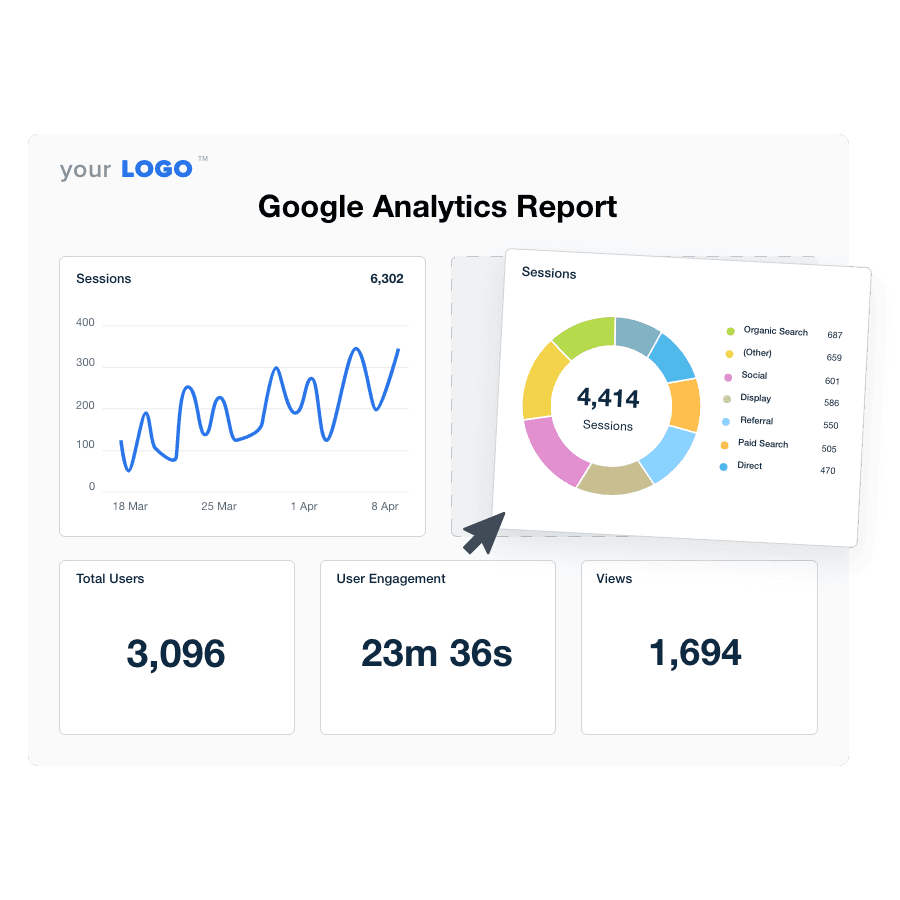
Monitor website performance, social media metrics, PPC data, and more. Show healthcare marketing clients the full ROI of their efforts; try AgencyAnalytics, free for 14 days.
3. Healthcare email marketing metrics & KPIs
Healthcare clients want to know how engaged their patients are with their email marketing efforts. Whether it’s to ask for a review, send appointment reminders, or maintain communication, present the performance metrics they want to see in their dashboards.
Open rate:
Are your audience segmentations properly set up for your healthcare client? Do they cater to different age groups or demographics that specific content could be sent to? Are subject lines engaging? Monitoring their open rate gives valuable insight into whether or not subscribers care about information coming from your client.
Clickthrough rate:
Determine the relevance of the content you’re sending to specific audiences by monitoring the clickthrough rate in your dashboard. Showing this metric tells your client what is working and what isn’t and gives the opportunity to test different strategies to increase their clickthrough rates. For example, various call-to-actions, ie: including social media icons, trying different copy on the buttons, etc.
Unsubscribe rate:
If you notice a rise in unsubscribes, it could be an indication that you’re sending too many emails, the content isn’t resonating, or something else completely. Including this metric in your client’s healthcare dashboard provides a simple data point to start creating solutions.
Email integrations help your agency optimize its campaigns by comparing open and click history, analyzing list engagement based on subscriber behavior, and more.
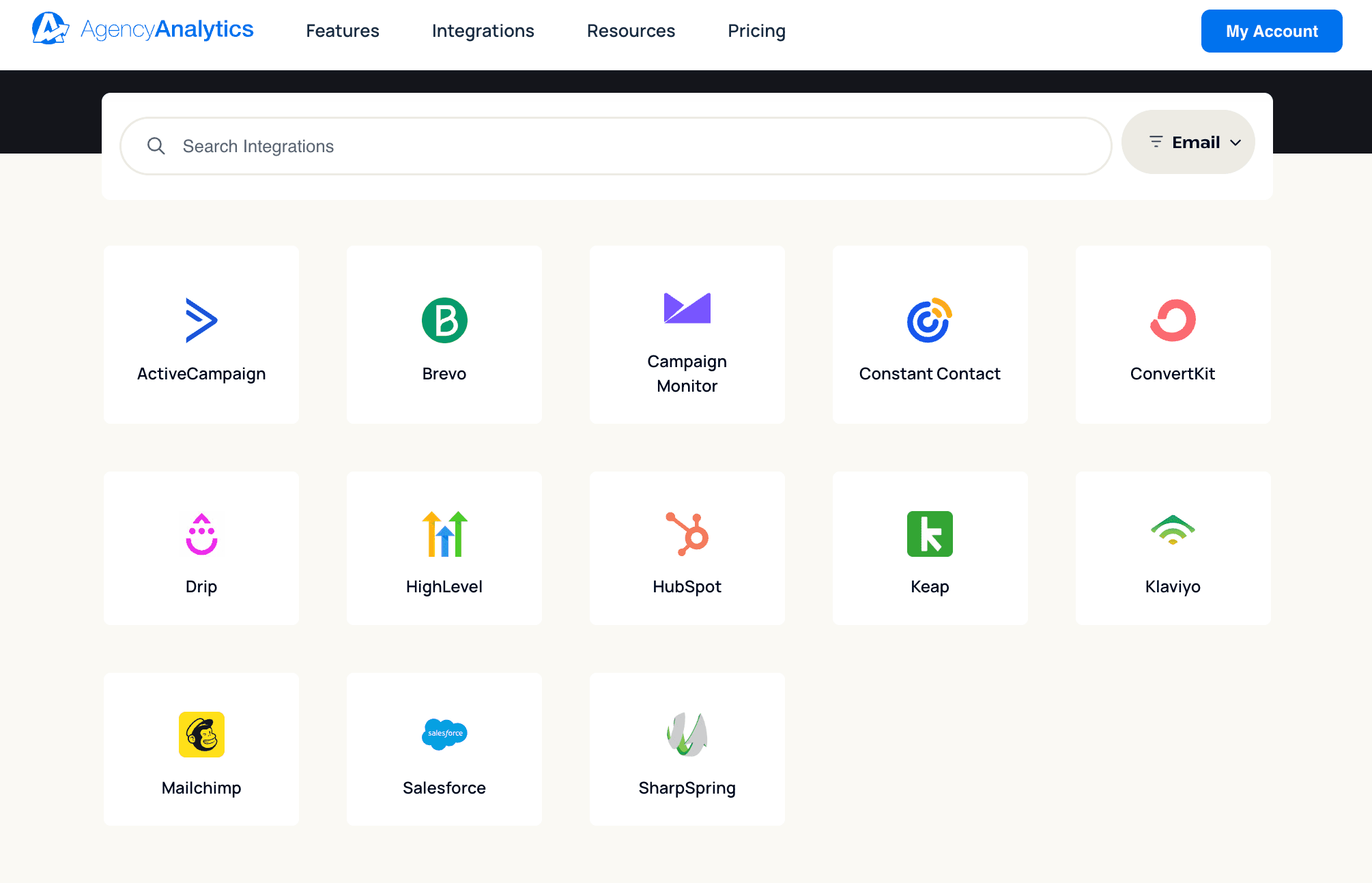
Access integrations across top email marketing platforms like Mailchimp, Constant Contact, and Keap. Consolidate data from 80+ channels in one place. Explore AgencyAnalytics, free for 14 days.
4. Healthcare social media metrics & KPIs
Your agency has social media campaigns in place to get your client’s services in front of the right people looking for them. Show your client a detailed overview of their social media efforts on a grander scale. Illustrate how their online community embraces their brand online through reviews, comments, new followers, and more.
Follower growth rate
Show your client their percentage of follower growth rate to indicate how fast their social media account is gaining followers compared to their previous count. This is a great way to communicate the benefits of working with your agency. For example, a higher growth rate means your campaigns are engaging and doing what they’re supposed to. However, if their growth rate is dipping, it’s an opportunity to optimize and create new strategies.
Facebook Insights page views:
If your client has a Facebook page, they’ll want to know the number of times their profile page has been viewed. This shows them how many high-intent searchers are looking for their business on social media platforms versus search engines or other sources.
Engagement:
Whether your agency is managing paid or organic social media, engagement is an important metric to monitor. Show your healthcare client how many times people have liked, shared, clicked, or commented on their posts which reflects how people find their posts useful or relevant.
5. Healthcare paid ads metrics & KPIs
Incorporating paid ad integrations in your dashboard breaks down the different paid activities by ad spend, helping your agency analyze crucial SEM metrics such as impressions, clicks, and more. At the end of the day, your healthcare clients want to know how much each new lead is costing them.
Cost per click:
Cost per click (CPC) is typically one of the metrics marketers look at closely for their clients. Including this metric in your healthcare marketing dashboard shows your client the effectiveness of their campaigns and how their advertising budget is being used. Your clients want to know what platform is driving the most clicks–especially in the highly competitive healthcare space.
Cost per conversion:
Show your client how much each new patient is costing them through their Google Ads or other paid ad campaigns. Use this as an opportunity to tell a story with their PPC data. For example, if their cost per conversion is too high, something needs to be adjusted (A/B testing, ad copy, etc.). On the other hand, if they have a good cost per conversion rate, you get to share the good news that their organization is converting visitors into customers cost-effectively–which is an excellent opportunity to recommend a budget increase.
Total campaign spend:
Of course, clients want to know how much they’re spending on campaigns and what kind of ROI they’ll get. Different healthcare practices will have varying marketing budgets, depending on the size and internal structure. Have a conversation with your healthcare client and determine what their campaign cost KPI is and how it will be measured in their dashboard.
6. Healthcare CRM metrics & KPIs
Connect your client’s CRM software–like Hubspot, Salesforce, or Brevo (formerly Sendinblue)– to their dashboard and get valuable insights such as patient relationship management, patient engagement, new patient acquisition, referral management, appointment scheduling, clinic reputation management, and more. Because CRM tools offer a variety of digital marketing solutions, it’s an integration you don’t want to miss when building your healthcare marketing dashboard.
Appointment forms completed:
If a clinic’s appointment forms are abandoned halfway through or patients are canceling appointments, everyone’s time and resources are being wasted. Measuring appointment forms completed helps your agency be proactive and address any issues that may occur.
Call tracking:
Be sure to track how many times a prospective patient used the phone number to call their clinic. Diving even further into their call tracking analytics shows them the source of client leads, filter for qualified leads, and so much more. Call tracking data also provides valuable insights into which campaigns or web pages are driving the most phone calls for appointment bookings.
Patient satisfaction scores:
The way this metric is measured from practice to practice can vary; however, one way to keep track of it is through surveys or online reviews. Post-appointment text messages are a great way to send a survey or Google Business Profile link to streamline the feedback process tracked in a dashboard. If your client is getting reviews on Yelp, your agency should develop a Yelp marketing initiative to boost local business leads.
Whatever type of dashboard your healthcare marketing agency decides to create, it should serve as a tool that turns data into helpful information to deliver better patient outcomes and offer proactive business solutions.
Healthcare marketing dashboard example
Your client's healthcare marketing dashboard should include a variety of visual elements such as charts, bar graphs, and numbers to tell a story with their data.
This is a healthcare marketing dashboard example that we've created with different sections that highlight their marketing campaigns, such as web analytics, email marketing, and social media.

Creating your healthcare marketing dashboard with AgencyAnalytics
Get started with your 14-day free trial with AgencyAnalytics to streamline your healthcare client’s marketing efforts. Whether you’re building detailed client reports or marketing dashboards, AgencyAnalytics has over 80 marketing integrations with available templates to help you get started.
Here are just a few of the 15 dashboard templates available to get you started.
Step 1
After logging into your AgencyAnalytics account, select the healthcare client’s profile.
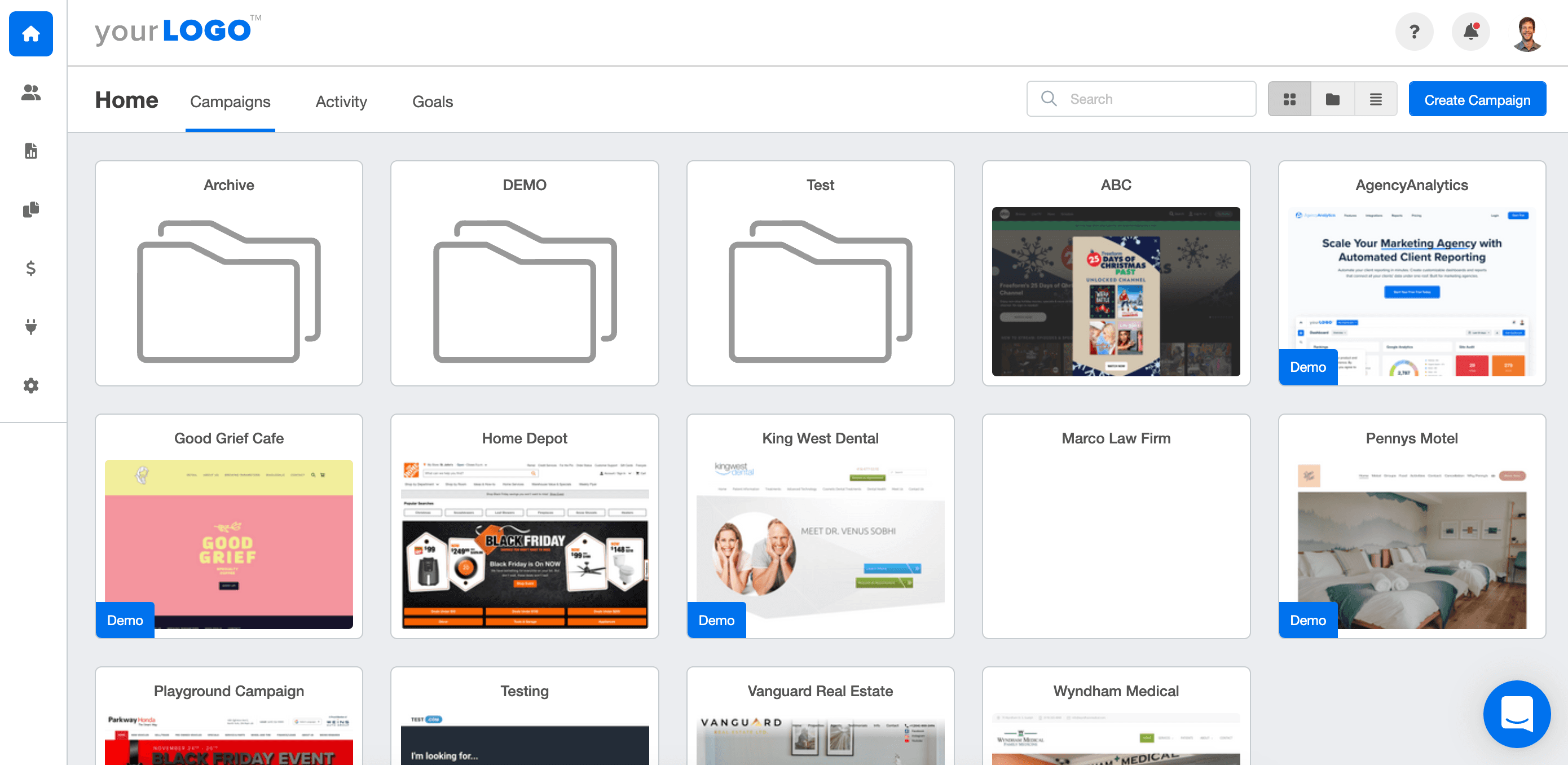
Step 2
Click "Add dashboard" in the left-hand menu.
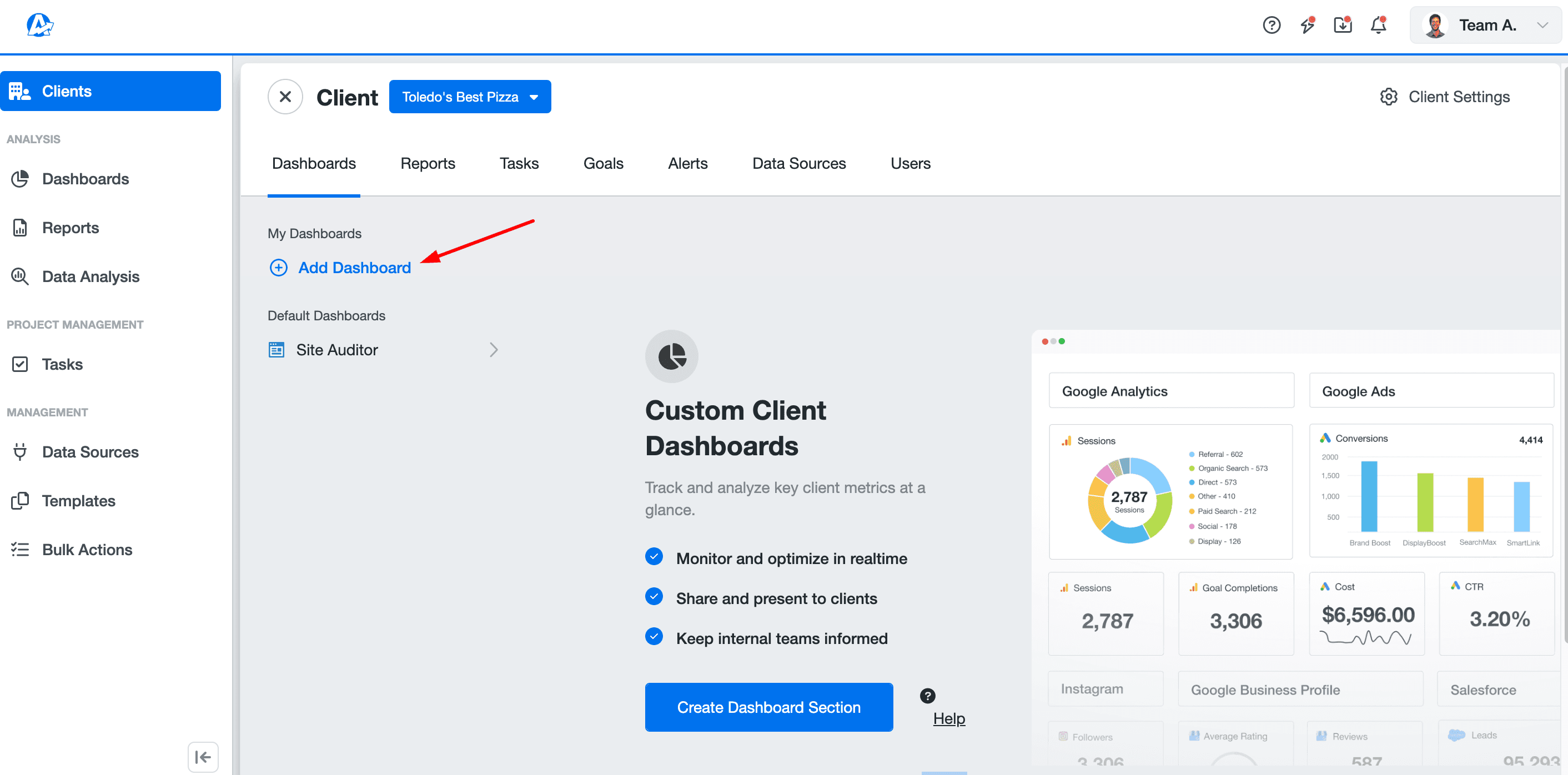
Step 3
Choose a source that you want to build your dashboard from: blank, template, or clone an existing dashboard.
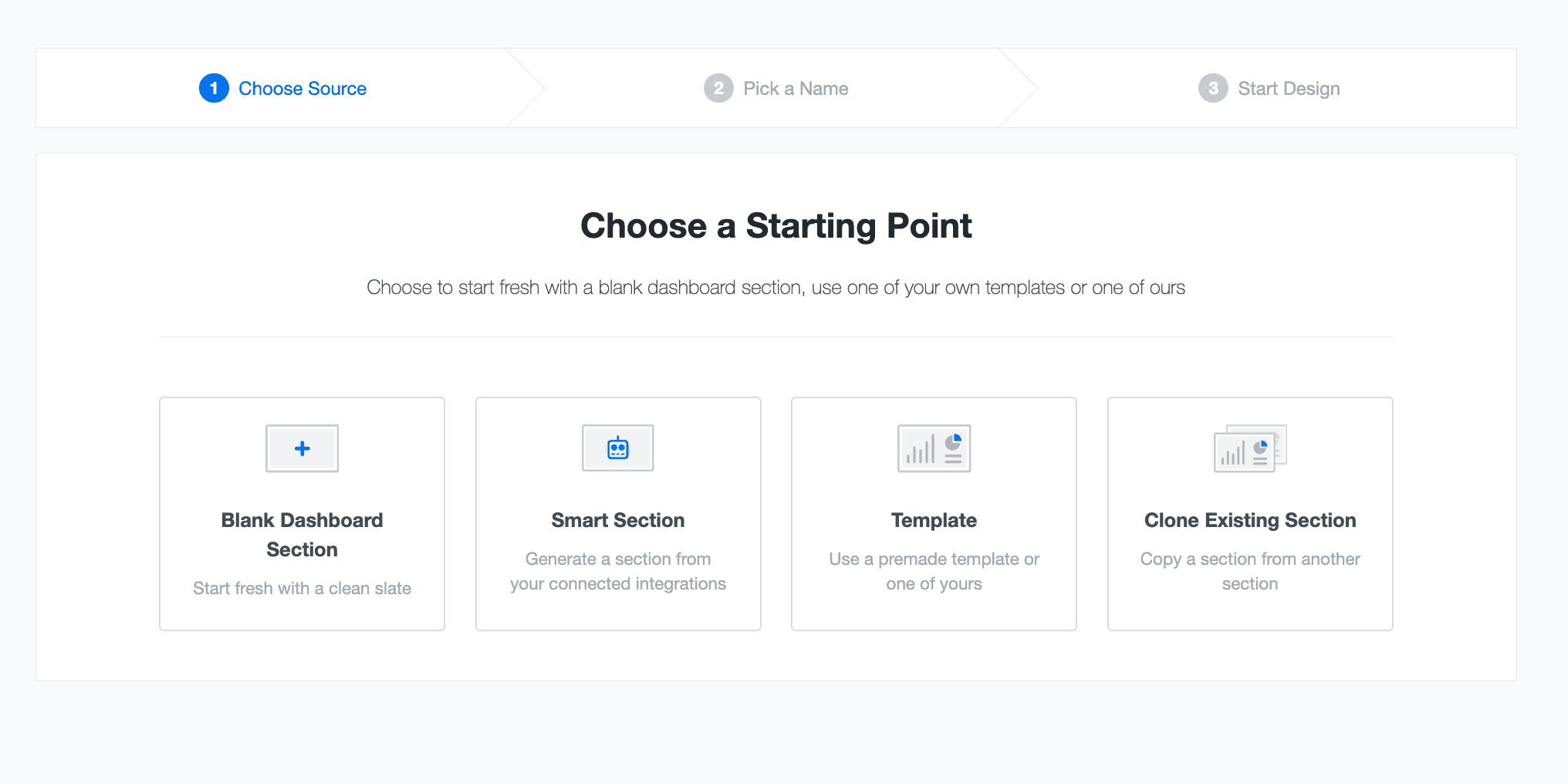
Step 4
Name and create your new dashboard. To make changes, click the "Edit dashboards" button in the top-right corner. Use the drag-and-drop editor, add media embeds, create custom metrics, and more.
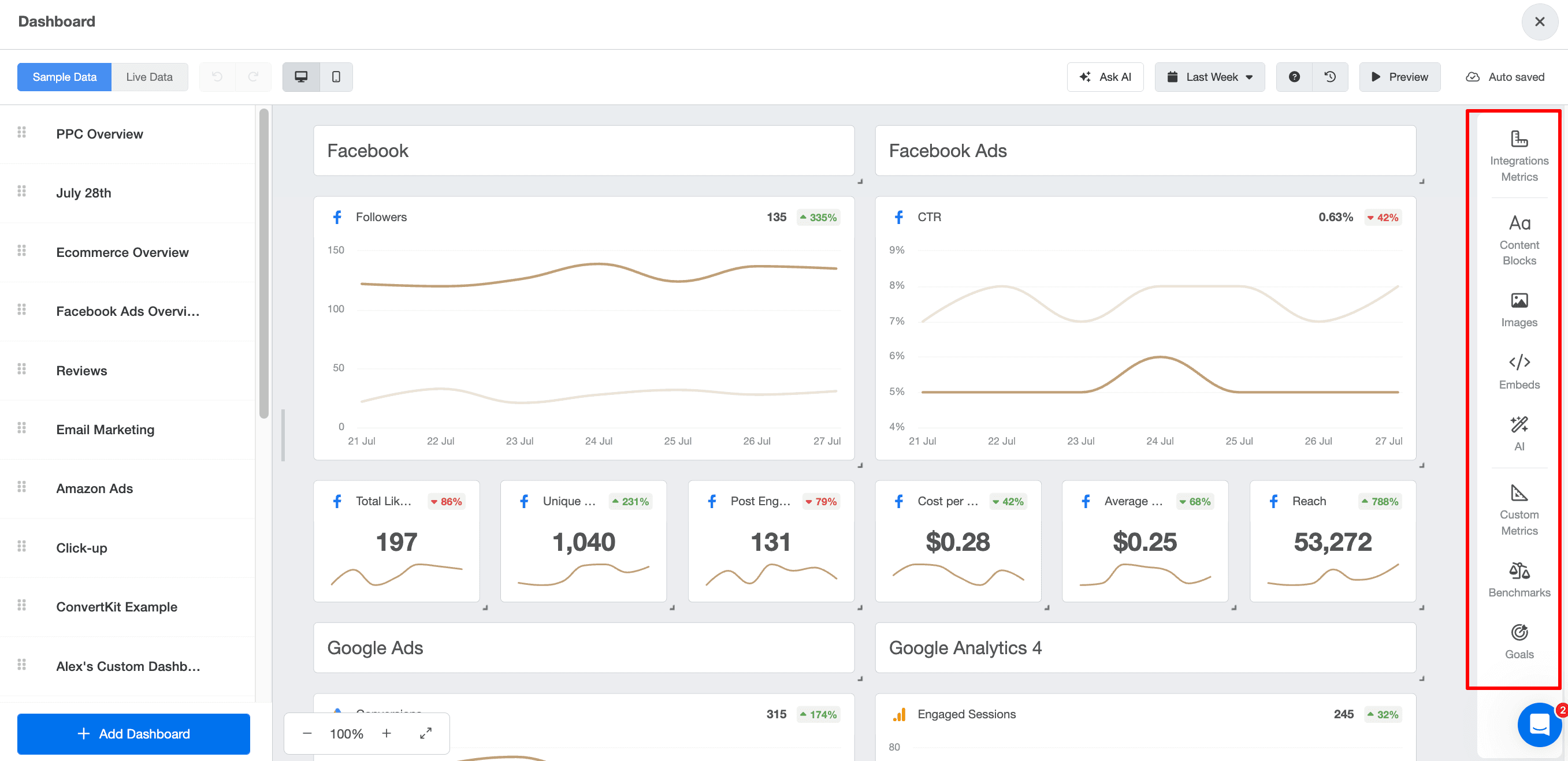
Flip your healthcare marketing dashboards into client-ready reports
Show off your agency’s expertise and value while growing your healthcare client’s practice by highlighting the marketing metrics that matter. Monitoring and reporting efforts should be as efficient as possible in order to ensure long-term agency success with healthcare clients.
Client reporting best practices dictate that client reports should be kept simple and easy to understand by incorporating data storytelling.
Create a client report to track your healthcare marketing results to show your clients the data they care about most. Even automate the entire process on a set schedule, create an AI-generated executive summary and add annotations. It's that simple!
Convert your healthcare marketing dashboards into professionally designed reports in minutes with a healthcare marketing report template—tailored for healthcare campaigns. Try AgencyAnalytics free for 14 days.

Written by
Richelle Peace is a writer with a degree in Journalism who focuses on web content, blog posts, and social media. She enjoys learning about different topics and sharing that knowledge with others. When she isn’t writing, Richelle spends time teaching yoga, where she combines mindfulness, movement, and her passion for wellness.
Read more posts by Richelle PeaceSee how 7,000+ marketing agencies help clients win
Free 14-day trial. No credit card required.



